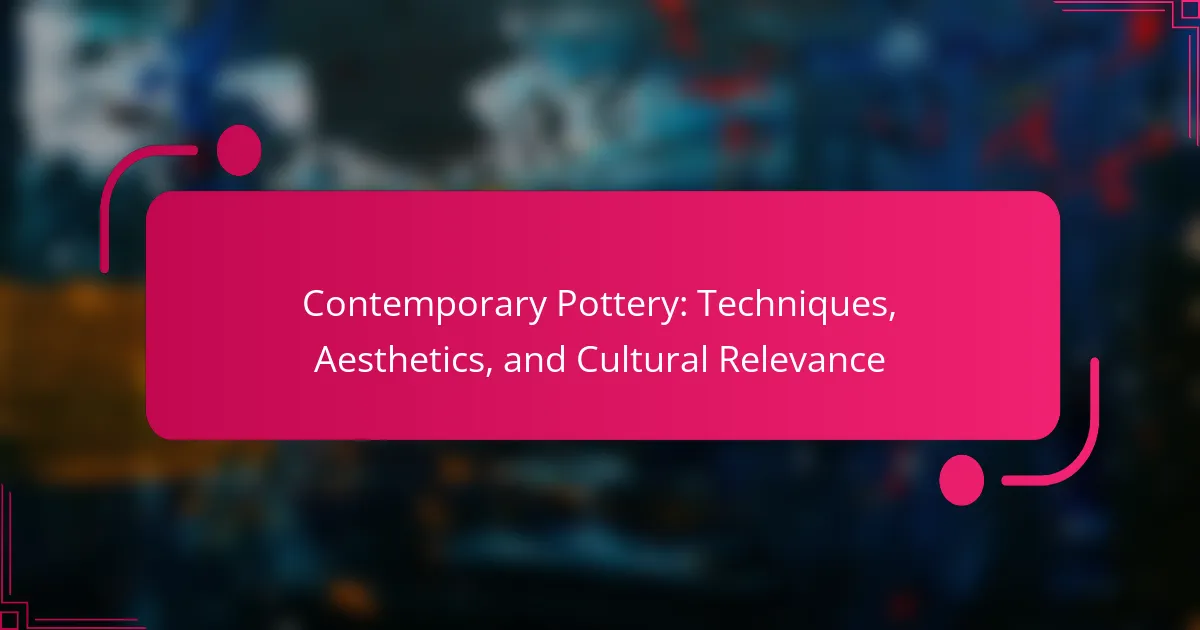Contemporary pottery stands at the intersection of artistry and functionality, showcasing innovative techniques and diverse aesthetics. This article explores key methods like wheel throwing and hand-building, examines the influence of aesthetics on design, and highlights the cultural relevance of pottery in today’s society. It also addresses sustainability practices and the challenges faced by modern potters while discussing emerging trends that shape the future of this craft.
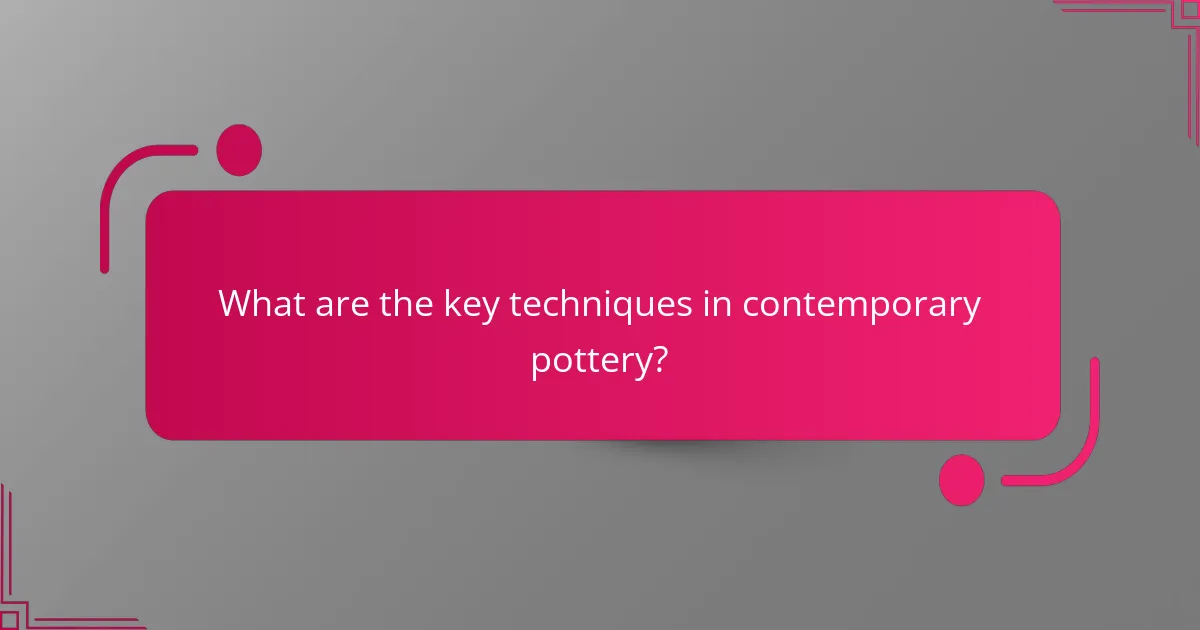
What are the key techniques in contemporary pottery?
Contemporary pottery employs various techniques that enhance both functionality and artistry. Key techniques include wheel throwing, hand-building, glazing, and firing methods.
Wheel throwing allows for uniform shapes and precise control, while hand-building techniques like pinch, coil, and slab construction enable unique forms. Glazing techniques, such as layering and sgraffito, add depth and texture to the surface. Firing methods, including electric, gas, and wood firing, influence the final aesthetic and durability of the pieces.
These techniques reflect a blend of tradition and innovation, showcasing the cultural relevance of contemporary pottery in artistic expression. Each approach contributes to the unique attributes of the final work, making contemporary pottery a dynamic field.
How does wheel throwing differ from hand-building methods?
Wheel throwing is a technique that utilizes a rotating wheel to shape clay, while hand-building methods involve shaping clay without mechanical assistance. Wheel throwing allows for uniformity and symmetry, making it ideal for creating functional pottery like bowls and vases. In contrast, hand-building techniques, such as pinch, coil, and slab methods, offer greater creative freedom and individuality, allowing artists to craft unique forms and textures. Each method serves different artistic intents, with wheel throwing emphasizing precision and hand-building highlighting personal expression.
What role does glazing play in modern pottery?
Glazing is essential in modern pottery, enhancing aesthetics and functionality. It provides a protective layer, influences texture, and affects color. Different glazing techniques can create unique visual effects, making each piece distinct. Additionally, glazing can impact the durability and usability of pottery, allowing for safe food and drink consumption.
Which firing techniques are commonly used today?
Contemporary pottery employs various firing techniques, each influencing the final aesthetic and durability. Common methods include oxidation firing, reduction firing, and raku firing. Oxidation firing occurs in an oxygen-rich environment, producing vibrant colors. Reduction firing limits oxygen, enhancing earthy tones and textures. Raku firing, a rapid process, creates unique crackle effects and variations in glaze. Each technique contributes distinct characteristics to pottery, reflecting the artist’s intent and cultural significance.
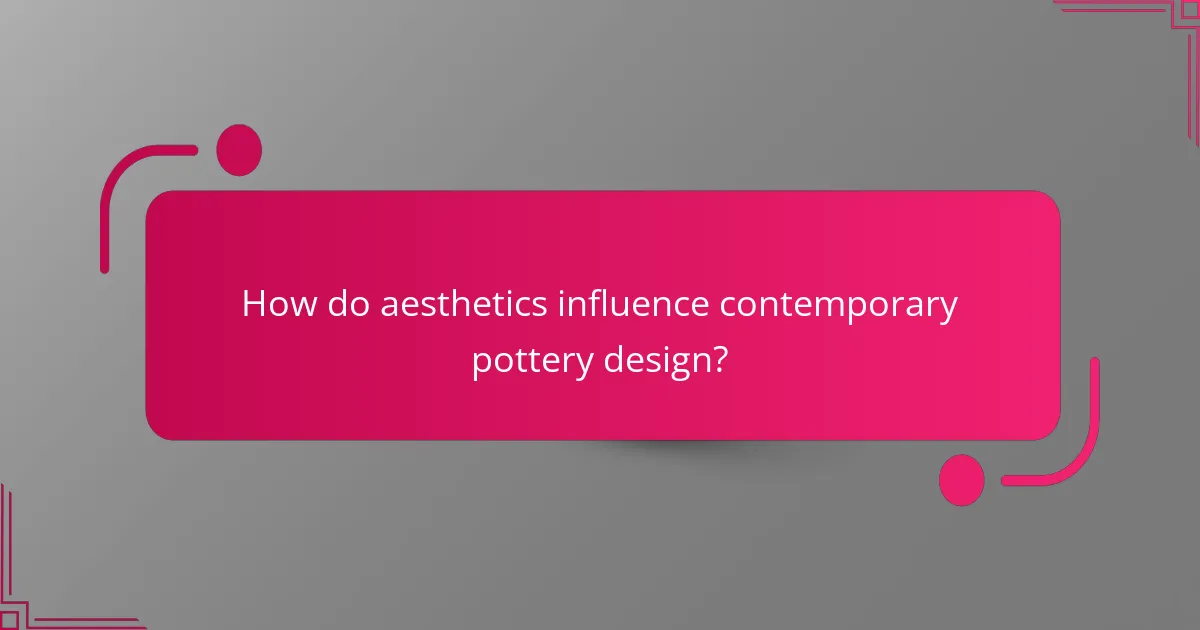
How do aesthetics influence contemporary pottery design?
Aesthetics significantly shape contemporary pottery design by influencing form, color, and texture. The integration of minimalist and organic styles reflects cultural narratives and personal expression. Artists often prioritize sustainable materials, enhancing visual appeal while promoting environmental responsibility. Unique attributes, such as glaze techniques, create distinctive finishes that resonate with modern tastes.
What color trends are emerging in pottery aesthetics?
Emerging color trends in pottery aesthetics include earthy tones, vibrant hues, and pastel shades. Earthy colors like terracotta and olive green evoke a connection to nature. Vibrant hues such as cobalt blue and deep red add boldness, while pastels like soft pink and mint green offer a calming aesthetic. These trends reflect a blend of traditional influences and modern interpretations. As a result, contemporary pottery showcases a diverse palette that caters to various tastes and interior styles.
How do cultural influences shape pottery styles?
Cultural influences significantly shape pottery styles through techniques, aesthetics, and meanings. Regional traditions, available materials, and historical contexts contribute to unique forms and designs. For example, Japanese pottery emphasizes simplicity and natural beauty, reflecting Zen philosophies. In contrast, Mexican pottery often features vibrant colors and intricate patterns, showcasing cultural narratives. These elements highlight how cultural identity and heritage manifest in contemporary pottery practices.
Which forms and shapes are popular in current pottery?
Popular forms and shapes in contemporary pottery include minimalist vessels, sculptural pieces, and functional wares. These designs often emphasize organic shapes, asymmetry, and texture. Unique attributes like hand-built techniques and experimental glazing are prevalent. Additionally, cultural influences manifest in traditional motifs and modern interpretations.
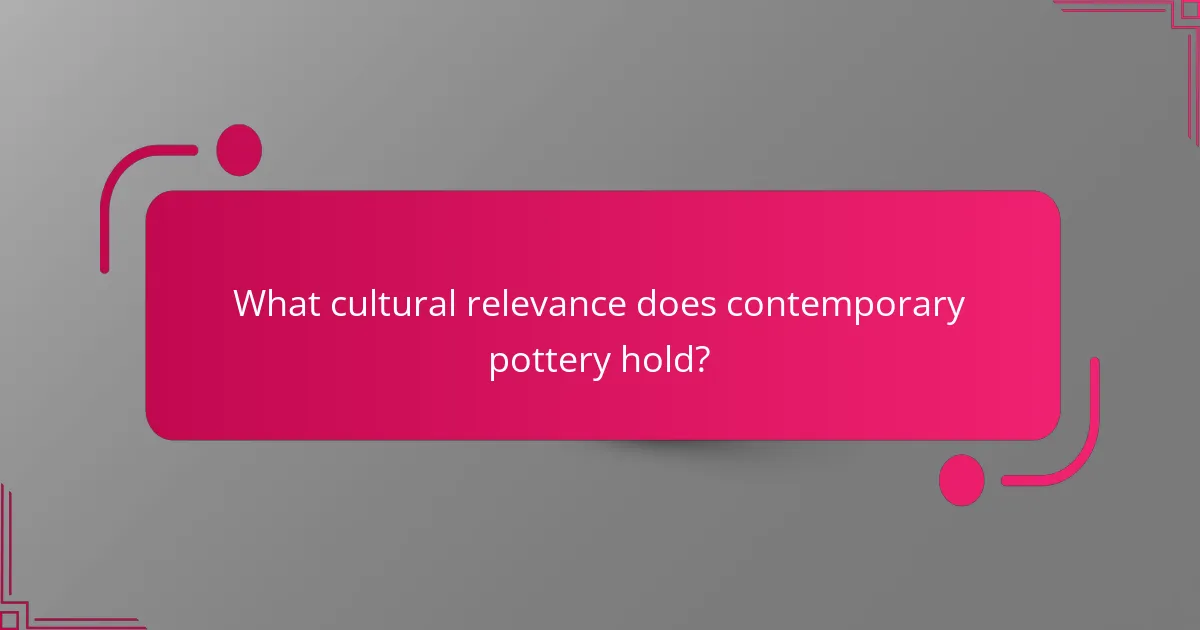
What cultural relevance does contemporary pottery hold?
Contemporary pottery holds significant cultural relevance as it embodies artistic expression, community identity, and historical continuity. It reflects diverse cultural narratives and techniques, integrating traditional practices with modern aesthetics. Potters often draw inspiration from cultural heritage, creating pieces that resonate with contemporary societal themes. This fusion fosters a dialogue between past and present, making pottery a vital medium for cultural storytelling. Additionally, contemporary pottery promotes sustainability by utilizing eco-friendly materials, aligning with global movements toward environmental awareness. Through exhibitions and collaborations, artists engage audiences, enhancing appreciation for this craft and its cultural significance.
How does contemporary pottery reflect social issues?
Contemporary pottery reflects social issues by addressing themes such as identity, sustainability, and community. Artists often use their work to comment on cultural heritage and environmental concerns. For example, many potters incorporate recycled materials, promoting eco-consciousness. The aesthetics of contemporary pottery often blend traditional techniques with modern concepts, fostering dialogue about cultural relevance. This unique fusion allows artists to express personal narratives while engaging with broader societal challenges.
In what ways does pottery contribute to community identity?
Pottery contributes to community identity by reflecting cultural heritage and fostering social connections. Through unique designs and techniques, pottery embodies local traditions and values. Community events centered around pottery, such as workshops and exhibitions, enhance collaboration and creativity. Artisans often draw inspiration from their surroundings, creating pieces that resonate with shared experiences. This engagement strengthens communal bonds and promotes a sense of belonging.
Which cultural events celebrate contemporary pottery?
Contemporary pottery is celebrated through various cultural events worldwide. Notable events include the National Council on Education for the Ceramic Arts (NCECA) conference, which showcases contemporary ceramic artists and their innovations. The International Ceramics Festival in Wales highlights global pottery practices and techniques. Additionally, local art fairs often feature contemporary pottery exhibitions, promoting regional artists and their unique styles. These events collectively emphasize the cultural relevance and evolving aesthetics of contemporary pottery.
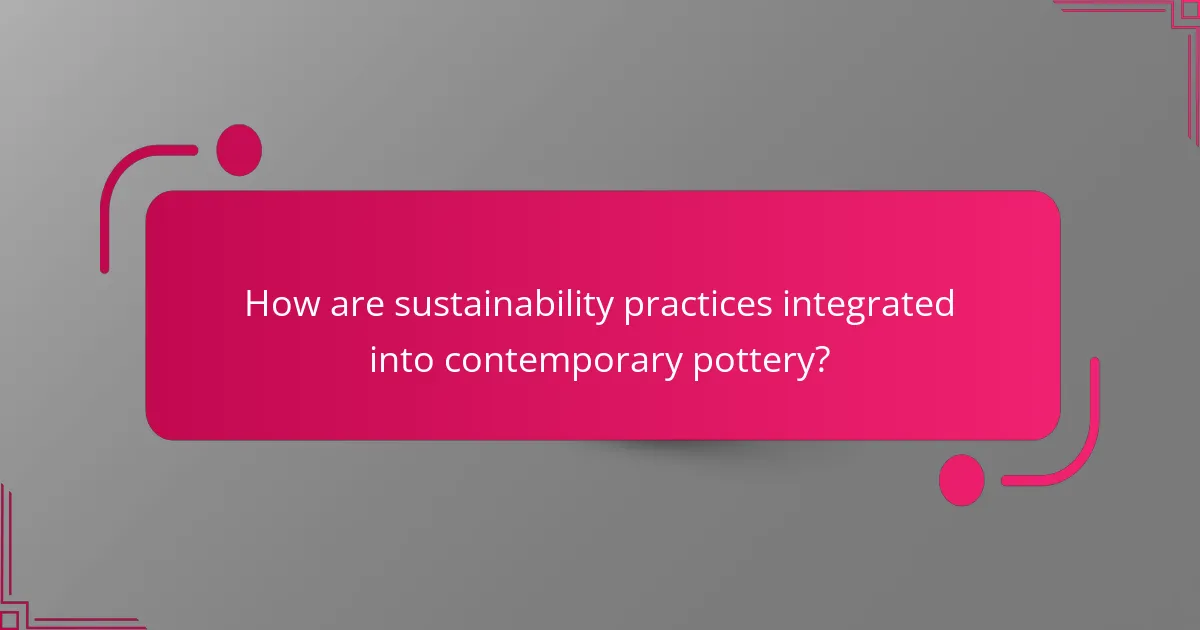
How are sustainability practices integrated into contemporary pottery?
Sustainability practices in contemporary pottery are integrated through eco-friendly materials, energy-efficient firing techniques, and waste reduction strategies. Artists prioritize natural glazes and locally sourced clays, minimizing environmental impact.
Many potters adopt renewable energy sources, such as solar power, for kilns, reducing carbon footprints. Additionally, recycling and upcycling materials are common, allowing for creative expression while promoting sustainability.
The unique attribute of contemporary pottery lies in its ability to blend artistry with environmental responsibility, appealing to eco-conscious consumers. As a result, this integration fosters a deeper cultural relevance, connecting craftsmanship with ecological awareness.
What materials are prioritized for eco-friendly pottery?
Eco-friendly pottery prioritizes sustainable materials like clay, natural glazes, and recycled components. These materials minimize environmental impact while maintaining aesthetic and functional qualities.
Natural clay is favored for its abundance and biodegradability. Organic glazes derived from plant sources enhance safety and sustainability. Recycled materials, such as glass or ceramic scraps, are increasingly used to reduce waste.
Additionally, some potters explore alternative firing techniques that utilize renewable energy sources, further supporting eco-friendly practices. These choices reflect a commitment to environmental stewardship in contemporary pottery.
How do potters minimize waste in their processes?
Potters minimize waste through techniques such as recycling clay, using efficient glazing methods, and designing multi-functional pieces. Recycling clay allows potters to reclaim material that would otherwise be discarded. Efficient glazing minimizes excess application, reducing runoff. Designing multi-functional pieces maximizes utility from a single item, decreasing the need for additional creations.
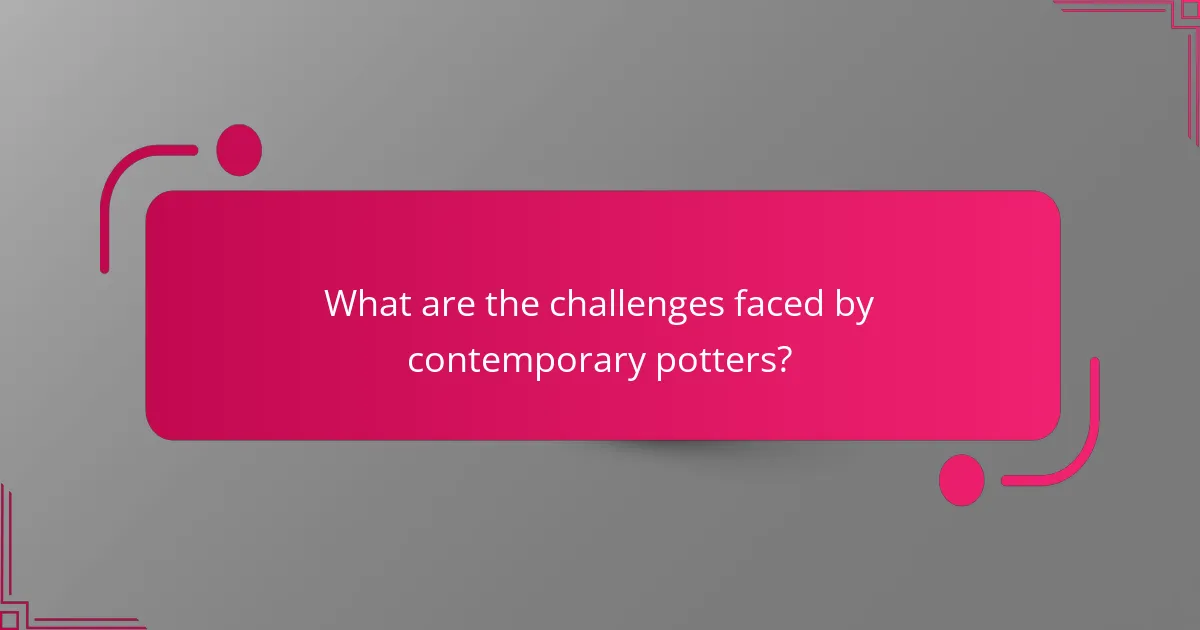
What are the challenges faced by contemporary potters?
Contemporary potters face challenges such as market saturation, evolving consumer preferences, and the need for sustainable practices. Competition from mass-produced ceramics affects pricing and visibility. Additionally, balancing traditional techniques with innovative aesthetics is crucial for cultural relevance. Potters must navigate these complexities to maintain their artistic identity and business viability.
How does market demand affect pottery production?
Market demand significantly influences pottery production by dictating trends, pricing, and the types of pieces created. When consumer interest shifts towards specific styles or functionalities, potters adapt their techniques and aesthetics accordingly. For instance, a rise in demand for sustainable materials can lead to increased production of eco-friendly pottery. Additionally, local cultural relevance often shapes the market, with potters creating works that resonate with community values and preferences. As a result, understanding market demand is essential for potters to thrive in a competitive landscape.
What are common financial hurdles for pottery artists?
Pottery artists face several financial hurdles that can impact their practice. High material costs, including clay and glazes, strain budgets. Equipment expenses for kilns and tools can be significant. Limited market access affects sales, while inconsistent income from commissions and exhibitions creates financial instability. Additionally, the need for studio space incurs rent or utility costs, further complicating financial management.
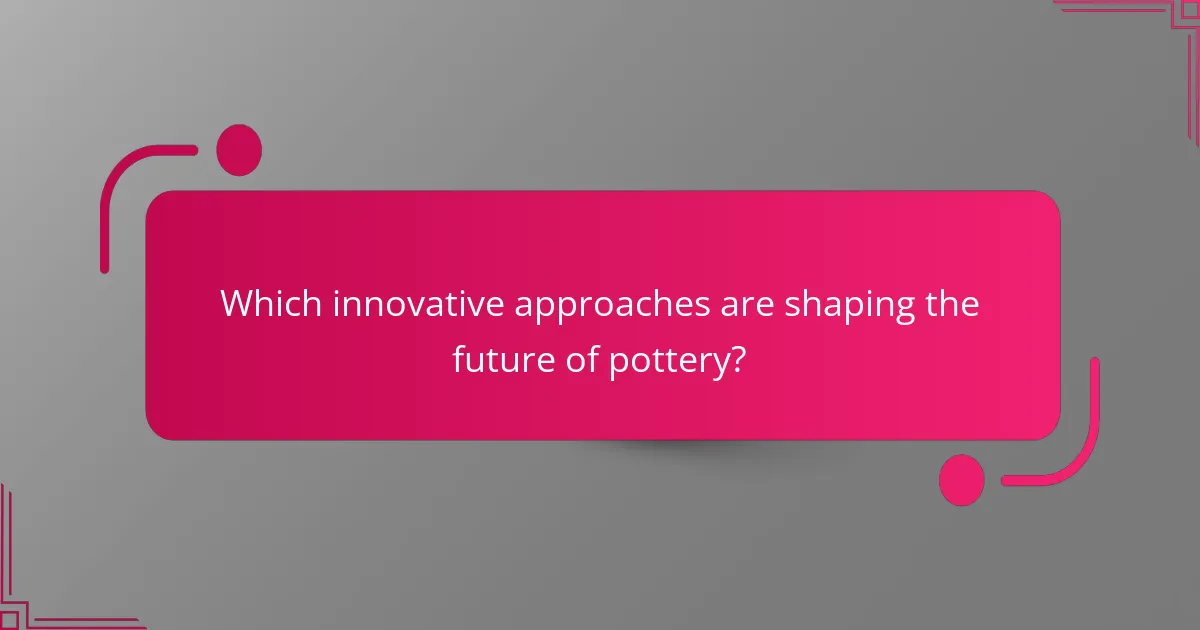
Which innovative approaches are shaping the future of pottery?
Innovative approaches shaping the future of pottery include the integration of technology, sustainable materials, and community engagement. These trends enhance artistic expression and cultural relevance.
1. Technology: 3D printing and digital design tools enable unique forms and precision in pottery creation.
2. Sustainability: Artists are increasingly using eco-friendly materials, reducing waste, and promoting environmental consciousness.
3. Community Engagement: Collaborative projects and workshops foster connections between artists and local communities, enriching cultural narratives.
4. Mixed Media: Combining pottery with other art forms creates diverse expressions and expands the scope of traditional pottery.
5. Global Influences: Cross-cultural exchanges inspire new techniques and aesthetics, reflecting a broader range of artistic traditions.
6. Conceptual Art: Pottery is evolving into a medium for conceptual exploration, challenging conventional definitions and purposes.
How is technology influencing pottery creation?
Technology significantly influences pottery creation through advanced tools and techniques. Innovations like 3D printing and digital design software allow artists to experiment with intricate shapes and patterns. These technologies enhance precision and open new avenues for creativity. Additionally, electric kilns provide better temperature control and energy efficiency, improving the firing process. As a result, contemporary pottery reflects a blend of traditional craftsmanship and modern technology, enriching its cultural relevance and aesthetic appeal.
What new materials are being explored in contemporary pottery?
Contemporary pottery explores innovative materials such as recycled clay, bio-based glazes, and 3D-printed components. These materials enhance sustainability and creativity in design. For instance, recycled clay reduces waste while maintaining aesthetic quality. Bio-based glazes offer eco-friendly alternatives to traditional materials, promoting environmental responsibility. Additionally, 3D printing allows for intricate designs that challenge conventional pottery techniques, expanding artistic possibilities.

What best practices should aspiring potters follow?
Aspiring potters should focus on mastering techniques, understanding aesthetics, and appreciating cultural relevance. First, practice fundamental skills like hand-building and wheel-throwing to develop a strong foundation. Second, explore various glazing methods to enhance visual appeal. Third, study pottery traditions from different cultures to inspire creativity and innovation. Finally, engage with the pottery community for feedback and collaboration, which fosters growth and new perspectives.
How can potters effectively market their work?
Potters can effectively market their work by leveraging social media, participating in local art fairs, and building a strong online presence. Engaging storytelling about their techniques and cultural relevance enhances connection with potential buyers. Collaborating with local businesses can also expand visibility and reach. Additionally, offering workshops or classes can showcase their skills and attract interest in their pottery.
What are common mistakes to avoid in pottery?
Common mistakes to avoid in pottery include improper clay preparation, inadequate drying time, and neglecting kiln temperature. These issues can lead to cracks, warping, or glaze defects.
1. Skipping wedging: Failing to wedge clay properly can result in air bubbles, causing cracks during firing.
2. Overworking clay: Excessive handling can weaken the clay structure and lead to deformation.
3. Ignoring drying stages: Insufficient drying can cause pieces to crack or explode in the kiln.
4. Miscalculating glaze application: Applying too much or too little glaze can lead to uneven surfaces or defects.
5. Not testing kiln settings: Incorrect temperature settings can ruin pieces, leading to underfired or overfired results.
6. Disregarding safety: Not using proper ventilation or protective gear can pose health risks during the pottery process.
How can potters continuously improve their skills?
Potters can continuously improve their skills through consistent practice, education, and experimentation. Engaging in workshops enhances technique and creativity. Seeking feedback from peers fosters growth and innovation. Exploring diverse styles broadens aesthetic understanding and cultural relevance. Documenting progress helps identify strengths and areas for improvement.
